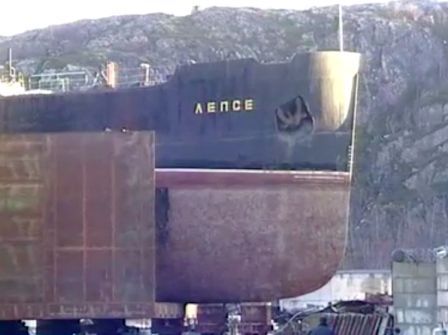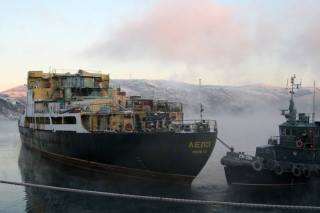
The system built to manage Russia’s nuclear legacy is crumbling, our new report shows
Our op-ed originally appeared in The Moscow Times. For more than three decades, Russia has been burdened with the remains of the Soviet ...
News

Publish date: October 29, 2014
Written by: Anna Kireeva
News
MURMANSK – Russia’s most dangerous nuclear vessel, the Lepse, was yesterday finally put into dry dock at the Nerpa shipyard north of Murmansk, where it spent nuclear fuel laden hull will be cut into sections and stored, officials at the shipyard told Bellona in interviews.
The Lepse, which was taken out of the business of unloading spent nuclear fuel from Soviet nuclear icebreakers in 1988, has spent the last two years hung up in traffic jams at the Nerpa shipyard waiting for the dry dock into which it was painstakingly maneuvered late yesterday afternoon Murmansk time, as shown here in local television broadcasts (in Russian).
Andrei Zolotkov, director of Bellona Murmansk said that any news that the Lepse is nearing dismantlement is good to hear – regardless of whether the process often seems to be moving in fits and starts.
“Today, as the vessel was finally put on dry land, we can forget the chilling term ‘floating Chernobyl’ [which has so often been applied to the Lepse], and from today forward, a potential threat to the Kola Bay has disappeared,” said Zolotkov. “Congratulations are in order for the technicians at Nerpa for their successful completion of a very important stage in the Lepse’s dismantlement.”
Nils Bøhmer, Bellona’s managing director and nuclear physicist said from Oslo that the dry-docking of the Lepse is a significant achievement.
“It’s very good that Russian authorities have finally gotten Lepse into dry dock and will soon begin the job of eliminating this nuclear threat,” Bøhmer said.
“In 1994 Bellona put the Lepse on the international agenda when we persuaded the EU to allocate the initial funds toward removing it from Kola Bay and dismantling it, and it since then been an important international project,” Bøhmer added. “This is therefore a great day, as efforts to eliminate the nuclear threat are now entering their final and decisive phase.”
Alexander Nikitin, chairman of the Environmental Rights Center (ERC) Bellona said the dry-docking was a major step, one from which there was no return – but also a stage at which there was the most to lose.
“Dry-docking the [Lepse] is that step from which there is no turning back […],” said Nikitin. “On the other hand, we have to take account of the fact that the most significant and the most dangerous stage of dismantlement is upon us, and it is here that we must be most careful and not rush to complete the operation of removing the most dangerous damaged fuel rods, and observe maximum caution.”

The Lepse contains 639 spent nuclear fuel assemblies stored in casks and caissons in its irradiated holds. A significant portion of these spent nuclear fuel assemblies were damaged during refueling operations of the nuclear icebreaker Lenin in 1965 and 1967 which resulted in coolant leaks that deformed the fuel elements, making their extraction for storage impossible by conventional means.
Mustafa Kashka, first deputy director of the Russian icebreaker port Atomflot, where the Lepse was moored for two decades before it was moved to Nerpa in September 2012, told a press briefing at the shipyard that removing the vessel from the water was the most important step so far toward minimizing its contamination threat to the environment.
Furthermore, said Kashka, it’s now possible “to move on to the following stages of the project, specifically constructing a protective structure surrounding it and the subsequent removal of spent nuclear fuel.”
On October 22, the Lepse was moved into a floating dock at Nerpa’s wharf number 3. The docking procedure took some 10 hours.

Nerpa representatives told Bellona this was a relatively complex operation, as putting the vessel into the dock was carried out by using block containers that affixed it in place.
During the two years it was located at Nerpa’s wharf number three, work to remove the Lepse’s larger outside metal structures was undertaken, the dry dock was fitted with additional needed equipment and a sheaf of new documents pertaining to licensing its dismantlement were inked.
In the best case, dismantlement of remaining structures on the Lepse will be completed between December 2014 and February 2015. As autumn approaches, the ship is expected to be cut into five sections, which will take the remainder of the year, according to new timelines Nerpa provided Bellona in early October.
Keeping the public informed
According to Bellona Murmansk’s Zolotkov, a public hearings and discussions will be required prior to the most potentially dangerous work on the Lepse’s dismantlement – the removal of the spent nuclear fuel/
Public hearings already took place in accordance with the state environmental impact study entitled “The Evaluation of the Environmental Impact during the Implementation of the Dismantlement of the Floating Technical Base the Lepse.”
“But there’s been a lot of water over the dam since then,” Zolotkov said, “and it would be completely appropriate to hold an open conversation about the project, taking into account all the changes that have taken place up to now.”
What is currently going on with the Lepse, said Zolotkov, “is just one stage in preparation for the most important part of the operation – unloading the nuclear fuel – and here there must be total clarity about the technology and risks that Nerpa technicians could encounter, as well as personnel who will not directly participate in the operation.”

Our op-ed originally appeared in The Moscow Times. For more than three decades, Russia has been burdened with the remains of the Soviet ...

The United Nation’s COP30 global climate negotiations in Belém, Brazil ended this weekend with a watered-down resolution that failed to halt deforest...

For more than a week now — beginning September 23 — the Zaporizhzhia Nuclear Power Plant (ZNPP) has remained disconnected from Ukraine’s national pow...

Bellona has taken part in preparing the The World Nuclear Industry Status Report 2025 and will participate in the report’s global launch in Rome on September 22nd.